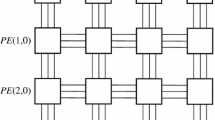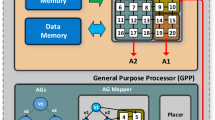Abstract
The reconfigurable mesh consists of an array of processors interconnected by a reconfigurable bus system. The bus system can be used to dynamically obtain various interconnection patterns among the processors. Recently, this model has attracted a lot of attention. In this paper, two efficient algorithms are proposed for computing the minimum spanning tree of ann-vertex undirected graph. One runs on ann×n reconfigurable mesh with time complexity ofO(log2 n). The other runs with time complexity ofO(logn) on ann 1+ε×n reconfigurable mesh, where 0<ε<1 is a constant. All these improve the previously known results on the reconfigurable mesh.
Similar content being viewed by others
References
Kruskal J B. On the shortest subtree of a graph and the travelling salesman problem. InProc. Amer. Math. Soc., 1956, 7(1): 48–50.
Prim R C. Shortest connection networks and some generalizations.Bell System Tech. J., 1957, 36(6): 1389–1401.
Sollin M. An Algorithm Attributed to Sollin. InIntroduction to the Design and Analysis of Algorithms, Goodman S E, Hedetniemi S T (eds.), McGraw-Hill, 1977.
Tsin Y H, Chin F Y. Efficient parallel algorithms for a class of graph theoretic problems.SIAM J. Comput., 1984, 13(3): 580–590.
Kwan S C, Ruzzo W L. Adaptive Parallel Algorithms for Finding Minimum Spanning Trees. InProc. Int. Conf. Parallel Processing, 1984, pp.439–443.
Nath D, Maheswari S N. Parallel algorithms for the connected components and minimal tree problems.Inform. Proc. Lett., 1982, 14(1): 7–11.
Huang M D. Solving Some Graph Problems with Optimal or Near-Optimal Speedup on Mesh-of-Trees Network. InProc. 26th Annu. IEEE Symp. FOCS, 1985, pp.232–240.
Maggs B M, Plotkin S A. Minimum-cost spanning trees as a path-finding problem.Inform. Proc. Lett., 1987/1988, 126: 291–293.
Miller R, Prasanna Kumar V K, Resis D, Stout Q F. Parallel computation on reconfigurable meshes.IEEE Trans. Computer, 1993, 42(6): 678–692.
Wang B F, Chen G H. Constant time algorithms for the transitive closure problem and some related graph problems with reconfigurable bus systems.IEEE Trans. Parallel and Distributed Systems, 1990, 1(4): 500–507.
Miller R, Prasanna Kumar V K, Resis D, Stout Q F. Meshes with Reconfigurable Buses. InProc. MIT Conf. Advanced Research in VLSI, Apr. 1988, pp.163–178.
Snyder L. Introduction to the configurable highly parallel computer.Computer, 1982, 15(1): 47–56.
Prasanna Kumar V K, Raghavendra C S. Array processor with multiple broadcasting.J. Parallel and Distributed Computing, 1987, 4: 173–190.
Rothstein J. Bus Automata, Brains, and Mental Models.IEEE Trans. System, Man, and Cybernetics, 1988, 18(4): 522–531.
Li H, Maresca M. Polymorphic-torus network.IEEE Trans. Computer, 1989, 38(9): 1345–1351.
Weems C C, Burrill J H. The Image Understanding Architecture and Its Programming Environment. InParallel Architectures and Algorithms for Image Understanding, Prasanna Kumar V K (ed.), Academic Press, 1991.
Kao T W, Horng S J. Computing Connected Components and Some Related Applications on RAP. InProc. ICPP, 1993, III-57–III-64.
Jenq J, Sahni S. Reconfigurable Mesh Algorithms for the Area and Primeter of Image Components. InProc. Int. Conf. Parallel Processing, Pennsylvania State Univ. Press, 1991, pp.280–281.
Miller R, Prasanna Kumar V K, Resis D, Stout Q F. Image Computations on Reconfigurable Mesh. InProc. IEEE Conf. Computer vision and Pattern Recognition, 1988, pp.925–930.
Resis D. An Efficient Convex Hull Computation on the Reconfigurable Mesh. InProc. Int. Parallel Processing Symp. ’92, 1992, pp.142–145.
Jang J W, Nigam M, Prasanna V K, Sahni S. Constant time algorithms for computational geometry on the reconfigurable mesh.IEEE Trans. Parallel and Distributed Systems, 1997, 8(1): 1–12.
Ben-Asher Y, Peleg D, Ramaswami R, Schuster A. The power of reconfiguration.J. Parallel and Distributed Computing, 1991, 13(2): 139–153.
Wang B F, Chen G H, Li H. Configurational Computation: A New Computation Method on Processor Arrays with Reconfigurable Bus Systems. InProc. Int. Parallel Processing Symp., 1991.
Jang J W, Park H, Prasanna V K. An optimalmultiplication algorithm on reconfigurable mesh.IEEE Trans. Parallel and Distributed Systems, 1997, 8(5): 521–532.
Jang J W, Prasanna V K. An Optimal Sorting Algorithm on Reconfigurable Mesh. InProc. Int. Parallel Processing Symp., Mar. 1992, pp.130–137.
Lin R, Olariu S, Schwing J, Zhang J. Sorting inO(1) Time on ann×n Reconfigurable Mesh. InProc. European Workshop on Parallel Computing, 1992, pp.16–27.
Nigam M, Sahni S. Sortingn Numbers onn×n Reconfiguable Meshes with Buses. Technical Report TR-92-04, Univ. of Florida, 1992.
Wang B F, Chen G H, Lin F C. Constant Time Sorting on a Processor Array with a Reconfigurable Bus System.Inform. Proc. Lett., 1990, 34: 187–192.
Joseph JàJà. An Introduction to Parallel Algorithms. Addison-Wesley, 1992.
Author information
Authors and Affiliations
Additional information
This work is supported by Ph.D. foundation of State Education Commission of China.
WAN Yingyu was born in 1976. He received the B.S. degree in computer science from University of Science and Technology of China in 1997. Now he is a Ph.D. candidate in computer science of University of Science and Technology of China. His current research interests include parallel computing and combinatorial optimization.
XU Yinlong was born in 1963. He received the B.S. degree in mathematics from Beijing University in 1983, and the M.S. degree in computer science from University of Science and Technology of China in 1989. His current research interests include parallel computing and combinatorial optimization algorithms.
GU Xiaodong was born in 1975. He received the B.S. degree in computer science from University of Science and Technology of China in 1997. Now he is a Ph.D. candidate in computer science of University of Science and Technology of China. His current research interests include parallel computing and combinatorial optimization.
CHEN Guoliang was born in 1938. He is a Professor and Ph.D. advisor in high performance parallel computing at University of Science and Technology of China. He is the Director of the National High Performance Computing Center at Hefei. His research interests include parallel computing, computer architecture, and combinatorial optimization.
Rights and permissions
About this article
Cite this article
Wan, Y., Xu, Y., Gu, X. et al. Efficient minimum spanning tree algorithms on the reconfigurable mesh. J. Comput. Sci. & Technol. 15, 116–125 (2000). https://doi.org/10.1007/BF02948795
Received:
Revised:
Issue Date:
DOI: https://doi.org/10.1007/BF02948795




